Spatiotemporal Characteristics of the Correlation among Tourism, CO2 Emissions, and Economic Growth in China
Abstract
:1. Introduction
- (1).
- The spatiotemporal evolution of China’s TE.
- (2).
- The spatiotemporal evolution and heterogeneity of TEI, demonstrating the correlation changes between tourism economic growth and CO2 emissions.
- (3).
- The spatiotemporal evolution of the effects of driving forces on China’s TE, demonstrating the correlation changes between tourism development and CO2 emissions.
2. Literature Review
2.1. Impact of Tourism on CO2 Emissions
2.2. TE Measurement
2.3. TEI
2.4. Driving Forces of TE
3. Materials and Methods
3.1. Research Framework
3.2. Methods and Data Sources
3.2.1. Bottom-Up Approach
3.2.2. TEI
3.2.3. Theil Index
3.2.4. ESDA
3.2.5. LMDI Method
3.2.6. Data Sources
4. Results and Analysis
4.1. Spatiotemporal Evolution of TE
4.1.1. Evolutional Characteristics of TE at National and Regional Scales
4.1.2. Evolutional Characteristics of TE at the Provincial Scale
4.2. Spatiotemporal Evolution of TEI
4.2.1. Evolutional Characteristics of TEI at National and Regional Scales
4.2.2. Evolutional Characteristics of TEI at the Provincial Scale
4.3. Spatial Differences of TEI
4.3.1. Overall Variance
4.3.2. Intra-Regional Differences
4.4. Spatial Autocorrelation of TEI
4.4.1. Global Spatial Autocorrelation Analysis
4.4.2. Local Spatial Autocorrelation Analysis
4.5. Spatiotemporal Effect of Driving Forces on TE Increment
4.5.1. Industrial Scale Effect
4.5.2. Industrial Economy Effect
4.5.3. Energy Intensity Effect
4.5.4. Spatial Structure Effect
4.5.5. Energy Structure Effect
5. Discussion
6. Conclusions
Author Contributions
Funding
Institutional Review Board Statement
Informed Consent Statement
Data Availability Statement
Acknowledgments
Conflicts of Interest
References
- UNWTO-UNEP-WMO. Climate Change and Tourism: Responding to Global Challenge; The World Tourism Organization and The United Nations Environment Programme: Madrid, Spain, 2008. [Google Scholar]
- Xu, B.; Lin, B. How industrialization and urbanization process impacts on CO2 emissions in China: Evidence from nonparametric additive regression models. Energy Econ. 2015, 48, 188–202. [Google Scholar] [CrossRef]
- IEA. Data and Statistics. Available online: https://www.iea.org/data-and-statistics/data-browser?country=CHINAREG&fuel=CO2%20emissions&indicator=CO2BySource (accessed on 16 August 2021).
- The Petroleum Corporation of BP. Statistical Review of World Energy, 70th ed.; 2021; Available online: https://www.bp.com/content/dam/bp/business-sites/en/global/corporate/pdfs/energy-economics/statistical-review/bp-stats-review-2021-full-report.pdf (accessed on 17 August 2021).
- Liu, J.; Feng, T.T.; Yang, X. The energy requirements and carbon dioxide emissions of tourism industry of western China: A case Chengdu city. Renew. Sust. Energ. Rev. 2011, 15, 2887–2894. [Google Scholar] [CrossRef]
- Chen, L.L.; Thapa, B.; Yan, W. The relationship between tourism, carbon dioxide emissions, and economic growth in the Yangtze River, China. Sustainability 2018, 10, 2118. [Google Scholar] [CrossRef] [Green Version]
- Jones, C.; Munday, M. Exploring the environmental consequences of tourism: A satellite account approach. J. Travel. Res. 2007, 46, 164–172. [Google Scholar] [CrossRef]
- Kuo, N.W.; Chen, P.H. Quantifying energy use, carbon dioxide emission, and other environmental loads from island tourism based on a life cycle assessment approach. J. Clean. Prod. 2009, 17, 1324–1330. [Google Scholar] [CrossRef]
- Tao, Y.G.; Huang, Z.F.; Shi, C.Y. Carbon dioxide emissions from regional tourism transport: A substitutional bottom-up analysis. Acta Ecol. Sinica 2015, 35, 4224–4233. [Google Scholar] [CrossRef] [Green Version]
- Yorucu, V. Growth impact of CO2 emissions caused by tourist arrivals in Turkey: An econometric approach. Int. J. Clim. Chang. Str. 2016, 8, 19–37. [Google Scholar] [CrossRef]
- Ma, H.Q.; Liu, J.L.; Xi, J.C. Decoupling and decomposition analysis of carbon emissions in Beijing’s tourism traffic. Environ. Dev. Sustain. 2022, 24, 5258–5274. [Google Scholar] [CrossRef]
- Achour, H.; Belloumi, M. Decomposing the influencing factors of energy consumption in Tunisian transportation sector using the LMDI method. Transp. Policy 2016, 52, 64–71. [Google Scholar] [CrossRef]
- Chen, J.; Zhao, A.; Zhao, Q.; Song, M.; Baležentis, T.; Streimikiene, D. Estimation and factor decomposition of carbon emissions in China’s tourism sector. Probl. Ekorozw. 2018, 13, 91–101. [Google Scholar]
- Sun, Y.Y. Decomposition of tourism greenhouse gas emissions: Revealing the dynamics between tourism economic growth, technological efficiency, and carbon emissions. Tour. Manag. 2016, 55, 326–336. [Google Scholar] [CrossRef]
- Tang, Z.; Jie, S.; Shi, C.; Liu, Z.; Bi, K. Decoupling indicators of CO2 emissions from the tourism industry in China: 1990–2012. Ecol. Indic. 2014, 46, 390–397. [Google Scholar] [CrossRef]
- Qiang, W.; Rongrong, L.; Rui, J. Decoupling and decomposition analysis of carbon emissions from industry: A case study of China. Sustainability 2016, 8, 1059–1076. [Google Scholar] [CrossRef] [Green Version]
- Zi, T.; Bai, S.; Shi, C.; Liu, L.; Li, X. Tourism-related CO2 emission and its decoupling effects in China: A spatiotemporal perspective. Adv. Meteorol. 2018, 2018, 1473184. [Google Scholar] [CrossRef] [Green Version]
- Gössling, S.; Peeters, P.; Ceron, J.P.; Dubois, G.; Patterson, T.; Richardson, R.B. The eco-efficiency of tourism. Ecol. Econ. 2005, 54, 417–434. [Google Scholar] [CrossRef]
- Sun, H.X.; Su, N.N. Analysis on spatio-temporal difference of tourism carbon emissions in northwest China. Hubei Agr. Sci. 2021, 2, 35–43. [Google Scholar] [CrossRef]
- Gössling, S.; Scott, D.; Hall, C.M. Challenges of tourism in a low-carbon economy. Clim. Chang. 2013, 4, 525–538. [Google Scholar] [CrossRef]
- Zaman, K.; Moemen, M.A.; Islam, T. Dynamic linkages between tourism transportation expenditures, carbon dioxide emission, energy consumption and growth factors: Evidence from the transition economics. Curr. Issues Tour. 2017, 20, 1720–1735. [Google Scholar] [CrossRef]
- Paramati, S.R.; Alam, M.S.; Lau, C.K.M. The effect of tourism investment on tourism development of CO2 emissions: Empirical evidence from the EU nations. J. Sustain. Tour. 2018, 26, 1587–1607. [Google Scholar] [CrossRef]
- The Fourteenth Five-Year Plan for National Economic and Social Development of the People’s Republic of China and the Outline of Long-Term Objectives for 2035. Available online: http://www.gov.cn/xinwen/2021-03/13/content_5592681.htm (accessed on 13 March 2021).
- Pan, Z.Q.; Liang, B.E. Research on space-time heterogeneity of tourism industry carbon emission intensity distribution and influencing factors: Analysis of panel data from 30 provinces (cities and districts) from 2005–2014. Human Geogr. 2016, 6, 152–158. [Google Scholar] [CrossRef]
- Zha, J.P.; Shu, H.Y.; He, L.M. A research on tourism industrial carbon emissions and its influential factors in China: Evidences from Chinese Provincial Panel Data (2005–2015). Tour. Sci. 2017, 31, 1–16. [Google Scholar] [CrossRef]
- Wang, J.B.; An, B.C.; Ma, G.C.; Lv, X.Q. Research on carbon emission intensity calculation and influencing factors of Provincial Tourism. Stats. Decision. 2019, 18, 99–102. [Google Scholar] [CrossRef]
- Chen, J.; Gao, M.; Cheng, S.; Hou, W.X.; Song, M.L.; Liu, X.; Liu, Y.; Shan, Y.L. County-level CO2 emissions and sequestration in China during 1997–2017. Sci. Data 2020, 7, 391–402. [Google Scholar] [CrossRef] [PubMed]
- Yang, Y.; Liu, Y. Study on China’s energy efficiency and its spatio-temporal variation from 1990 to 2010 based on DEA-ESDA. J. Nat. Res. 2014, 29, 1815–1825. [Google Scholar] [CrossRef]
- Liu, Y.; Yang, Z.; Wu, W. Assessing the impact of population, income and technology on energy consumption and industrial pollutant emissions in China. Appl. Energy 2015, 155, 904–917. [Google Scholar] [CrossRef]
- Yang, Z.; Liu, Y.S. Does population have a larger impact on carbon dioxide emissions than income? Evidence from a cross regional panel analysis in China. Appl. Energy 2016, 180, 800–809. [Google Scholar] [CrossRef]
- Wang, K.; Xiao, Y.; Li, Z.M.; Liu, H.L. Spatial analysis for regional difference of tourism carbon emissions in China. China Pop. Res. Environ. 2016, 26, 83–90. [Google Scholar] [CrossRef]
- Zhang, W.; Li, K.; Zhou, D.Q.; Zhang, W.R.; Gao, H. Decomposition of intensity of energy-related CO2 emission in Chinese provinces using the LMDI method. Energy Policy 2016, 92, 369–381. [Google Scholar] [CrossRef]
- Tang, C.C.; Zhong, L.S.; Ng, P. Factors that influence the tourism industry’s carbon emissions: A tourism area life cycle model perspective. Energy Policy 2017, 109, 704–718. [Google Scholar] [CrossRef]
- Stefănică, M.; Sandu, C.B.; Butnaru, G.I.; Haller, A.P. The nexus between tourism activities and environmental degradation: Romanian tourists’ opinions. Sustainability 2021, 13, 9210. [Google Scholar] [CrossRef]
- Lee, J.W.; Brahmasrene, T. Investigating the influence of tourism on economic growth and carbon emissions: Evidence from panel analysis of the European Union. Tour. Manag. 2013, 38, 69–76. [Google Scholar] [CrossRef]
- Katircioglu, S.T. Testing the tourism-induced EKC hypothesis: The case of Singapore. Econ. Model. 2014, 41, 383–391. [Google Scholar] [CrossRef]
- Paramati, S.R.; Alam, M.S.; Chen, C.F. The effects of tourism on economic growth and CO2 emissions: A comparison between developed and developing economies. J. Travel Res. 2017, 56, 712–724. [Google Scholar] [CrossRef] [Green Version]
- Paramati, S.R.; Shahbaz, M.; Alam, M.S. Does tourism degrade environmental quality? A comparative study of Eastern and Western European Union. Transp. Res. Part D Transp. Environ. 2017, 50, 1–13. [Google Scholar] [CrossRef]
- Katircioglu, S.T.; Feridun, M.; Kilinc, C. Estimating tourism-induced energy consumption and CO2 emissions: The case of Cyprus. Renew. Sustain. Energy Rev. 2014, 29, 634–640. [Google Scholar] [CrossRef]
- Gössling, S.; Lund-Durlacher, D. Tourist accommodation, climate change and mitigation: An assessment for Austria. J. Outdoor Recreat. Tour. 2021, 34, 100367. [Google Scholar] [CrossRef]
- Neger, C.; Prettenthaler, F.; Gössling, S.; Damm, A. Carbon intensity of tourism in Austria: Estimates and policy implications. J. Outdoor Recreat. Tour. 2021, 33, 100331. [Google Scholar] [CrossRef]
- Li, L.; Li, J.; Tang, L.; Wang, S. Balancing tourism’s economic benefit and CO2 emissions: An insight from input–output and tourism satellite account analysis. Sustainability 2019, 11, 1052. [Google Scholar] [CrossRef] [Green Version]
- Nagaj, R.; Žuromskaite, B. Tourism in the era of COVID-19 and its impact on the environment. Energies 2021, 14, 2000. [Google Scholar] [CrossRef]
- Lenzen, M.; Sun, Y.Y.; Faturay, F.; Ting, Y.P.; Geschke, A.; Malik, A. The carbon footprint of global tourism. Nature Climate Change 2018, 8, 522–528. [Google Scholar] [CrossRef]
- Gössling, S. National emissions from tourism: An overlooked policy challenge? Energy Policy 2013, 59, 433–442. [Google Scholar] [CrossRef]
- Zha, J.P.; Tan, T.; Yuan, W.W.; Yang, X.J.; Zhu, Y. Decomposition analysis of tourism CO2 emissions for sustainable development: A case study of China. Sustain. Dev. 2020, 28, 169–186. [Google Scholar] [CrossRef]
- Gössling, S. Global environmental consequences of tourism. Global Environ. Chang. 2002, 12, 283–302. [Google Scholar] [CrossRef]
- Gössling, S.; Peeters, P. Assessing tourism’s global environmental impact 1900–2050. J. Sustain. Tour. 2015, 23, 639–659. [Google Scholar] [CrossRef]
- Dubois, G.; Ceron, J.P. Tourism/Leisure Greenhouse Gas Emissions Forecasts for 2050: Factors for change in France. J. Sustain. Tour. 2006, 14, 172–191. [Google Scholar] [CrossRef]
- Robaina-Alves, M.; Moutinho, V.; Costa, R. Change in energy-related CO2 (carbon dioxide) emissions in Portuguese tourism: A decomposition analysis from 2000 to 2008. J. Clean. Prod. 2016, 111, 520–528. [Google Scholar] [CrossRef]
- Wang, J.C.; Wang, Y.C.; Li, K.; Wang, J.H. Greenhouse gas emissions of amusement parks in Taiwan. Renew. Sust. Energ. Rev. 2017, 74, 581–589. [Google Scholar] [CrossRef]
- Kelly, J.; Williams, P.W. Tourism destination energy consumption and greenhouse gas emissions: Whistler, British Columbia, Canada. Sustain. Tour. 2007, 15, 67–90. [Google Scholar] [CrossRef]
- Dwyer, L.; Forsyth, P.; Spurr, R.; Hoque, S. Estimating the carbon footprint of Australian tourism. J. Sustain. Tour. 2010, 18, 355–376. [Google Scholar] [CrossRef]
- Wu, P.; Shi, P.H. An estimation of energy consumption and CO2 emissions in tourism sector of China. J. Geogr. Sci. 2011, 21, 733–745. [Google Scholar] [CrossRef]
- Camelia, S.; Razva, S.M.; Breda, Z.; Ana-Irina, D. An Input-Output approach of CO2 emissions in tourism sector in Post-Communist Romania. Procedia Econ. Financ. 2012, 3, 987–992. [Google Scholar] [CrossRef]
- Zhong, Y.D.; Shi, S.Y.; Li, S.H.; Luo, F.; Luo, W.L. Empirical research on measurement framework construction for tourist industry carbon emission in China: A perspective of input-output. J. Cent. South Univ. Forest. Technol. 2015, 35, 132–139. [Google Scholar] [CrossRef]
- Munday, M.; Turner, K.; Jones, C. Accounting for the carbon associated with regional tourism consumption. Tour. Manag. 2013, 36, 35–44. [Google Scholar] [CrossRef]
- Becken, S.; Patterson, M. Measuring national carbon dioxide emissions from tourism as a key step towards achieving sustainable tourism. Tour. Manag. 2006, 31, 285–290. [Google Scholar] [CrossRef]
- Jones, C. Scenarios for greenhouse gas emissions reduction from tourism: An extended tourism satellite account approach in a regional setting. J. Sustain. Tour. 2012, 21, 458–472. [Google Scholar] [CrossRef]
- Meng, W.Q.; Xu, L.Y.; Hu, B.B. Quantifying direct and indirect carbon dioxide emissions of the Chinese tourism industry. J. Clean. Prod. 2016, 126, 586–594. [Google Scholar] [CrossRef]
- Perch-Nielsen, S.; Sesartic, A.; Stucki, M. The greenhouse gas intensity of the tourism sector: The case of Switzerland. Environ. Sci. Policy 2010, 13, 131–140. [Google Scholar] [CrossRef]
- Yao, D.; Ren, L.Y.; Ma, R.F.; Li, Z.K.; Wang, C.J. Analysis of spatial pattern and influencing factors of carbon emissions intensity of tourism industry in Yangtze River Delta. Ecol. Sci. 2021, 40, 89–98. [Google Scholar] [CrossRef]
- Wang, K.; Zhang, J.J.; Geng, Y.H.; Xiao, L.X.; Xu, Z.; Rao, Y.H.; Zhou, X.L. Differential spatial-temporal responses of carbon dioxide emissions to economic development: Empirical evidence based on spatial analysis. Mitig. Adapt. Strat. Gl. 2020, 25, 237–260. [Google Scholar] [CrossRef]
- Wang, R.; Xia, B.; Dong, S.; Li, Y.; Li, Z.; Ba, D.; Zhang, W. Research on the Spatial Differentiation and Driving Forces of Eco-Efficiency of Regional Tourism in China. Sustainability 2021, 13, 280. [Google Scholar] [CrossRef]
- Geng, Y.; Zhao, H.Y.; Liu, Z.; Xue, B.; Fujita, T.; Xi, F.M. Exploring driving factors of energy related CO2 emissions in Chinese provinces: A case of Liaoning. Energy Policy 2013, 60, 820–826. [Google Scholar] [CrossRef]
- Ang, B.W.; Zhang, F.Q. A survey of index decomposition analysis in energy and environmental studies. Energy 2000, 25, 1149–1176. [Google Scholar] [CrossRef]
- Ang, B. Decomposition analysis for policy making in energy: Which is the preferred method. Energy Policy 2004, 32, 1131–1139. [Google Scholar] [CrossRef]
- Liu, J.; Chen, X.P.; Zhang, Z.L. Features and factors decomposition of carbon dioxide emissions of China’s tourism industry. Res. Indus. 2017, 19, 67–76. [Google Scholar] [CrossRef]
- Luo, F.; Moyle, B.D.; Moyle, C.J.; Zhong, Y.D.; Shi, S.Y. Drivers of carbon emissions in China’s tourism industry. J. Sustain. Tour. 2020, 28, 747–770. [Google Scholar] [CrossRef]
- Liu, Z.L.; Lu, C.P.; Mao, J.H.; Sun, D.Q.; Li, H.J.; Lu, C.Y. Spatial-temporal heterogeneity and the related influencing factors of tourism efficiency in China. Sustainability 2021, 13, 5825. [Google Scholar] [CrossRef]
- Patterson, M.; McDonald, G. How Clean and Green Is New Zealand Tourism; Lincoln: Manaki, Whenua, 2004; pp. 56–59. [Google Scholar]
- Carlsson-Kanyama, A.; Lindén, A.L. Travel patterns and environmental effects now and in the future: Implications of differences in energy consumption among socio-economic groups. Ecol. Econ. 1999, 30, 405–417. [Google Scholar] [CrossRef]
- Peeters, P.; Dubois, G. Tourism travel under climate change mitigation constraints. J. Transp. Geog. 2010, 18, 131–140. [Google Scholar] [CrossRef]
- Theil, H. Economics and Information Theory; North Holland Publishing Company: Amsterdam, The Netherlands, 1967. [Google Scholar]
- Zhang, W.; Bao, S. Created unequal: China’s regional pay inequality and its relationship with mega-trend urbanization. Appl. Geog. 2015, 61, 81–93. [Google Scholar] [CrossRef]
- Zhang, S.X.; Ning, Y.D. An Analysis on the Differences of Regional Energy Efficiency in China—The Empirical Study Based on Theil Index. Adv. Mat. Res. 2014, 830, 392–397. [Google Scholar] [CrossRef]
- Anselin, L. The Local Indicators of Spatial Association—LISA. Geogr. Anal. 1995, 27, 93–115. [Google Scholar] [CrossRef]
- Kaya, Y. Impact of Carbon Dioxide Emission on GNP Growth: Interpretation of Proposed Scenarios. Presentation to the Energy and Industry Subgroup; Response Strategies Working Group, IPCC: Geneva, Switzerland, 1989. [Google Scholar]
- Ang, B.W.; Zhang, F.Q.; Choi, K.H. Factorizing changes in energy and environmental indicators through decomposition. Energy 1998, 23, 489–495. [Google Scholar] [CrossRef]
- Ang, B.W.; Liu, F.L.; Chew, E.P. Perfect decomposition techniques in energy and environmental analysis. Energy Policy 2003, 31, 1561–1566. [Google Scholar] [CrossRef]
- National Tourism Administration of the People’s Republic of China. The Yearbook of China Tourism Statistics 2005; China Travel & Tourism Press: Beijing, China, 2005. [Google Scholar]
- Wang, Q.; Wu, S.D.; Li, T.T. Spatio-temporal characteristics of energy consumption and carbon emissions in industry sector during the period of economic transition in China. Scientia Geogr. Sin. 2011, 31, 36–41. [Google Scholar] [CrossRef]
- Gössling, S.; Scott, D.C.; Hall, M. Inter-market variability in CO2 emission-intensities in tourism: Implications for destination marketing and carbon management. Tour. Manag. 2015, 46, 203–212. [Google Scholar] [CrossRef]
- Gühnemann, A.; Kurzweil, A.; Mailer, M. Tourism mobility and climate change—A review of the situation in Austria. J. Outdoor Recreat. Tour. 2021, 34, 100382. [Google Scholar] [CrossRef]
- Fu, L.; Cao, Y.; Guo, H.; Kuang, S.Y. China’s Low-Carbon Development Progress and Policy Evaluation Since the 12th Five-Year Plan Period. Chin. J. Environ. Manag. 2021, 13, 16–24. [Google Scholar] [CrossRef]
- Tang, C.C.; Zha, J.P.; Zhang, J.K.; Tao, Y.G.; Wang, L.G.; Wang, L.; Han, Y. Dual-cabon goal of China’s tourism industry under high-quality development: Evaluation & prediction, major challenges and realization path. J. Chin. Ecotour. 2021, 11, 471–497. [Google Scholar] [CrossRef]
- Barbosa, R.B.; Costa, J.H.; Korstanje, M.E. The effect of COVID-19 in the tourist society: An anthropological insight of the trivialisation of death and life. Int. J. Tour. Anthrop. 2021, 8, 179–192. [Google Scholar] [CrossRef]
- Andrews, H. Tourism and COVID-19: Intimacy transformed or intimacy interrupted? Anthrop. Action 2020, 27, 93–100. [Google Scholar] [CrossRef]
- Huang, Y.T. Analysis of the impact of COVID-19 epidemic on tourism industry volatility under the background of big data. Front. Econ. Manag. 2020, 1, 189–193. [Google Scholar] [CrossRef]
- Sun, Y.Y.; Higham, J. Overcoming information asymmetry in tourism carbon management: The application of a new reporting architecture to Aotearoa New Zealand. Tour. Manag. 2021, 83, 104231. [Google Scholar] [CrossRef] [PubMed]
- Liu, W.D.; Tang, Z.P.; Xia, Y.; Jiang, W. Identifying the key factors influencing Chinese carbon intensity using machine learning, the random forest algorithm and evolutionary analysis. Acta Geogr. Sin. 2019, 74, 2592–2603. [Google Scholar]
- Han, Y.J.; Wu, P. The measurement and comparative study of carbon dioxide emissions from tourism industry of Beijing-Tianjin-Hebei. Human Geogr. 2016, 4, 127–134. [Google Scholar] [CrossRef]
- Sun, Y.Y. Estimation of CO2 emission and its effect decomposition in tourism sector of Shanghai city. Areal Res. Dev. 2020, 39, 122–126. [Google Scholar] [CrossRef]
- Xie, Y.J.; Wei, Y.D.; Hu, Y.C.; Wang, D.P.; Chen, F. Exploring the construction of Hainan International Tourism Consumption Center from the perspective of the integration of culture and tourism. Tour. Trib. 2019, 34, 12–22. [Google Scholar] [CrossRef]
- Wang, Z.; Cheng, J.H.; Cheng, Z.H. Regional differences and influencing factors of tourism carbon equilibrium in China. Acta Ecol. Sin. 2021, 41, 8063–8075. [Google Scholar] [CrossRef]
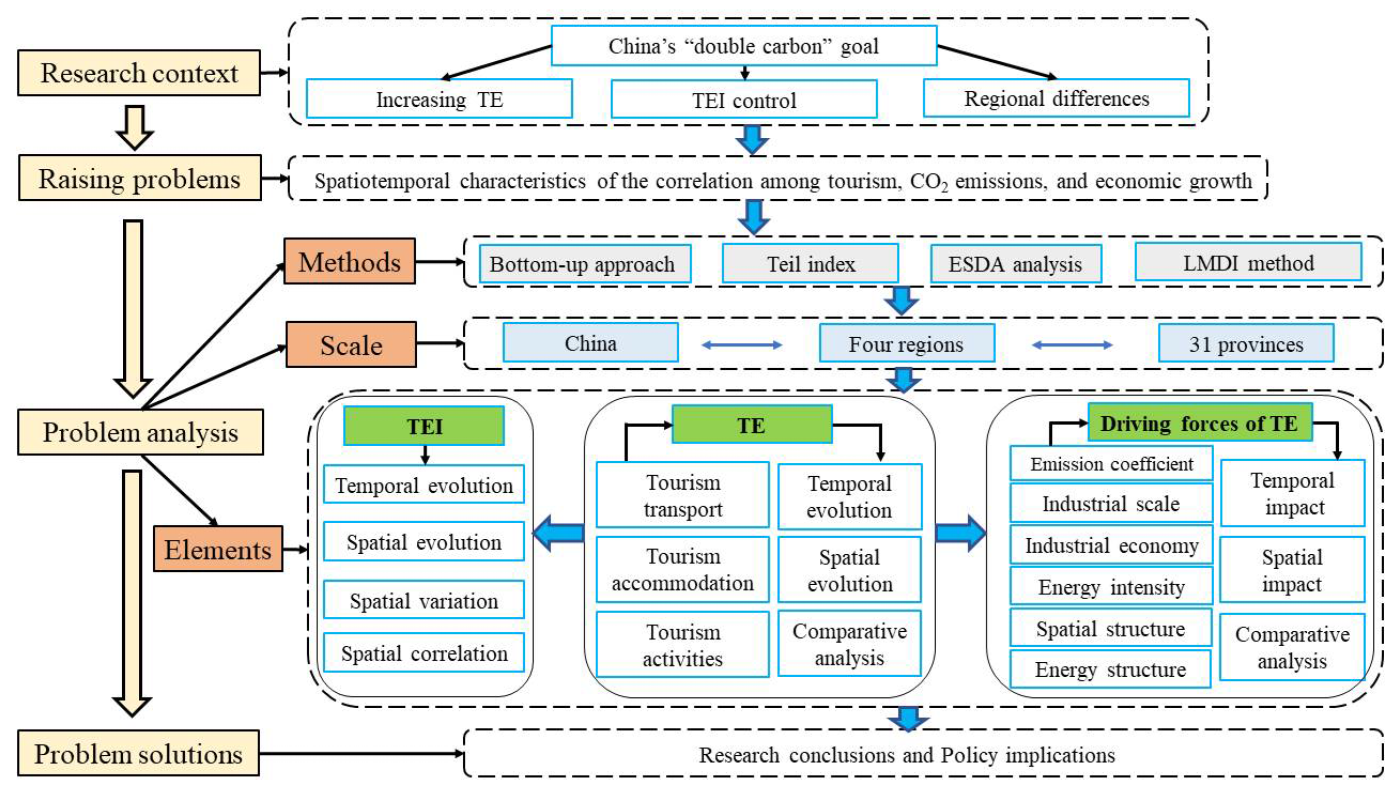

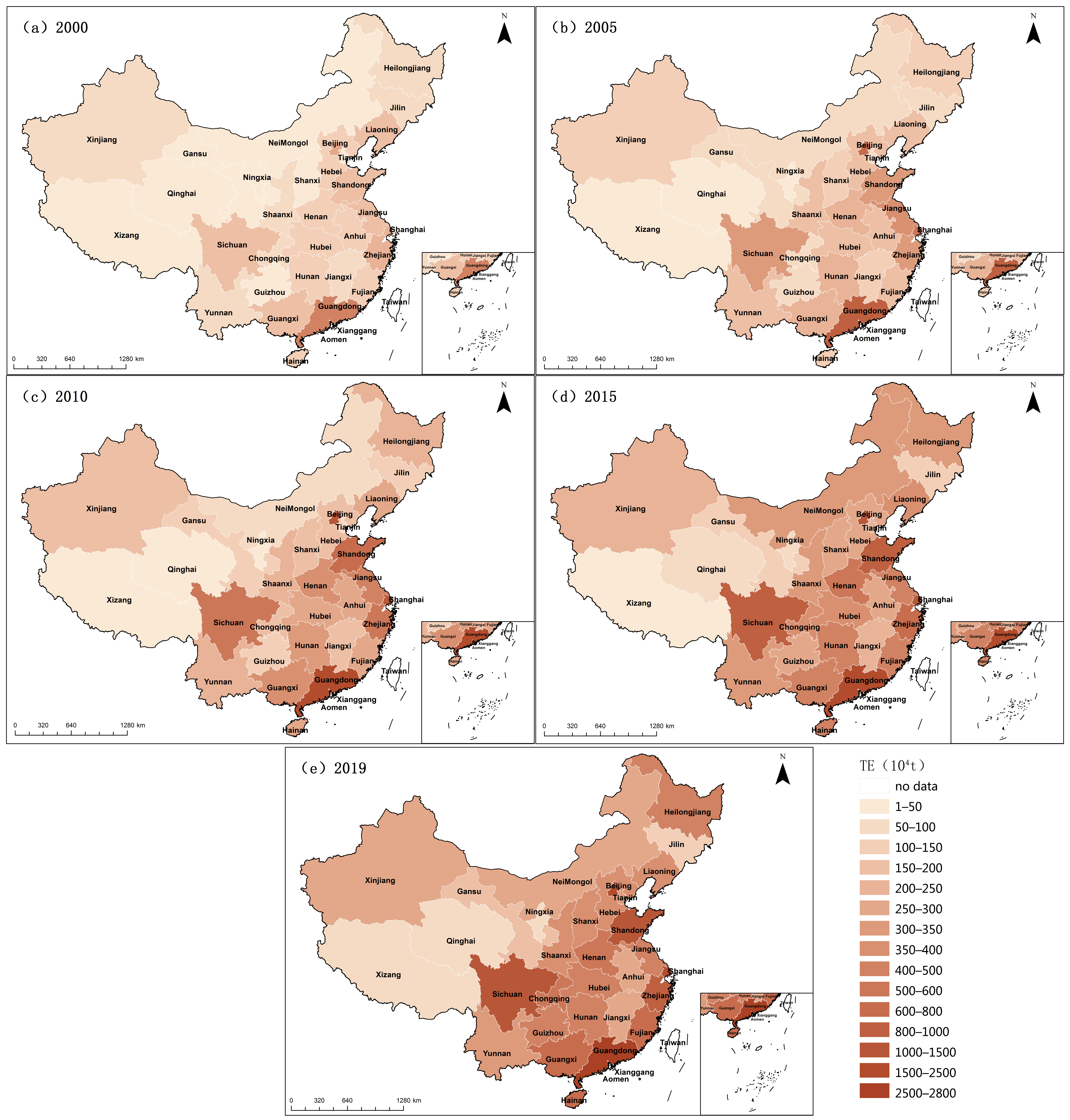
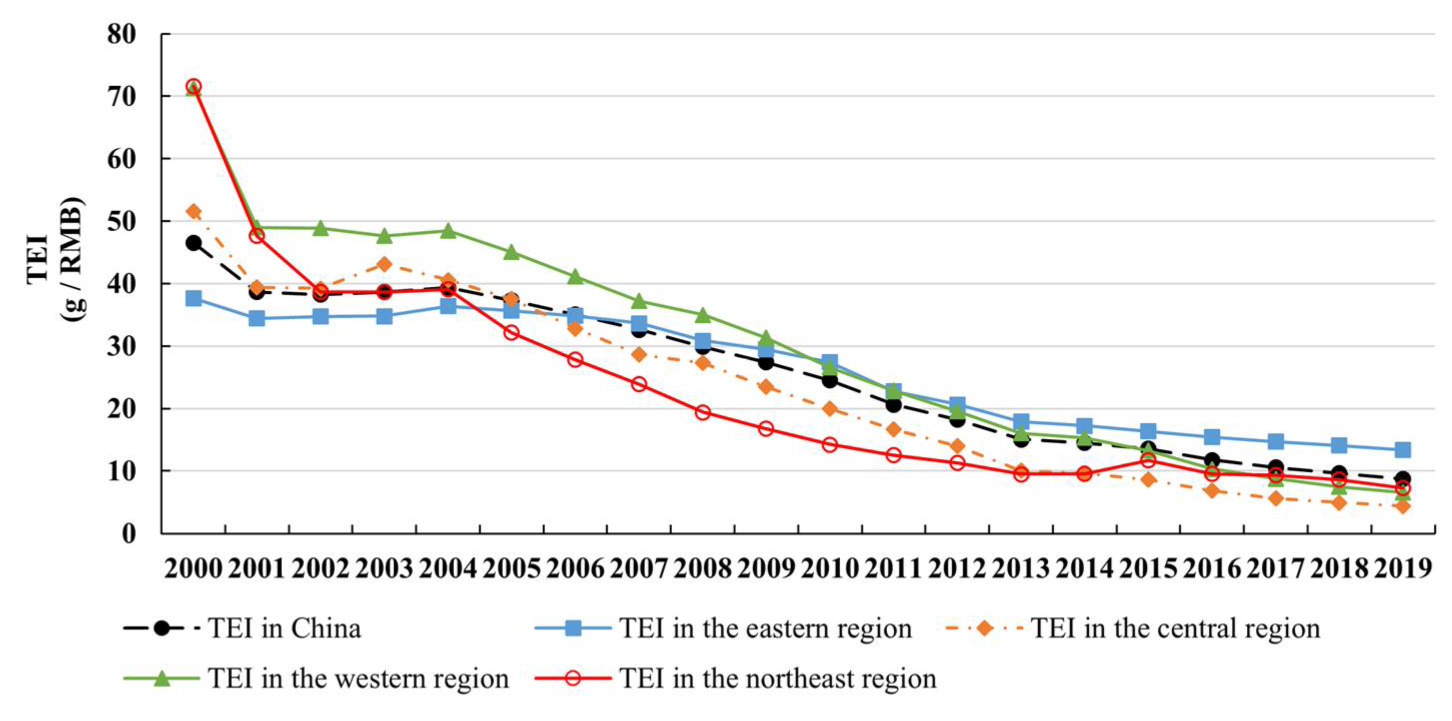
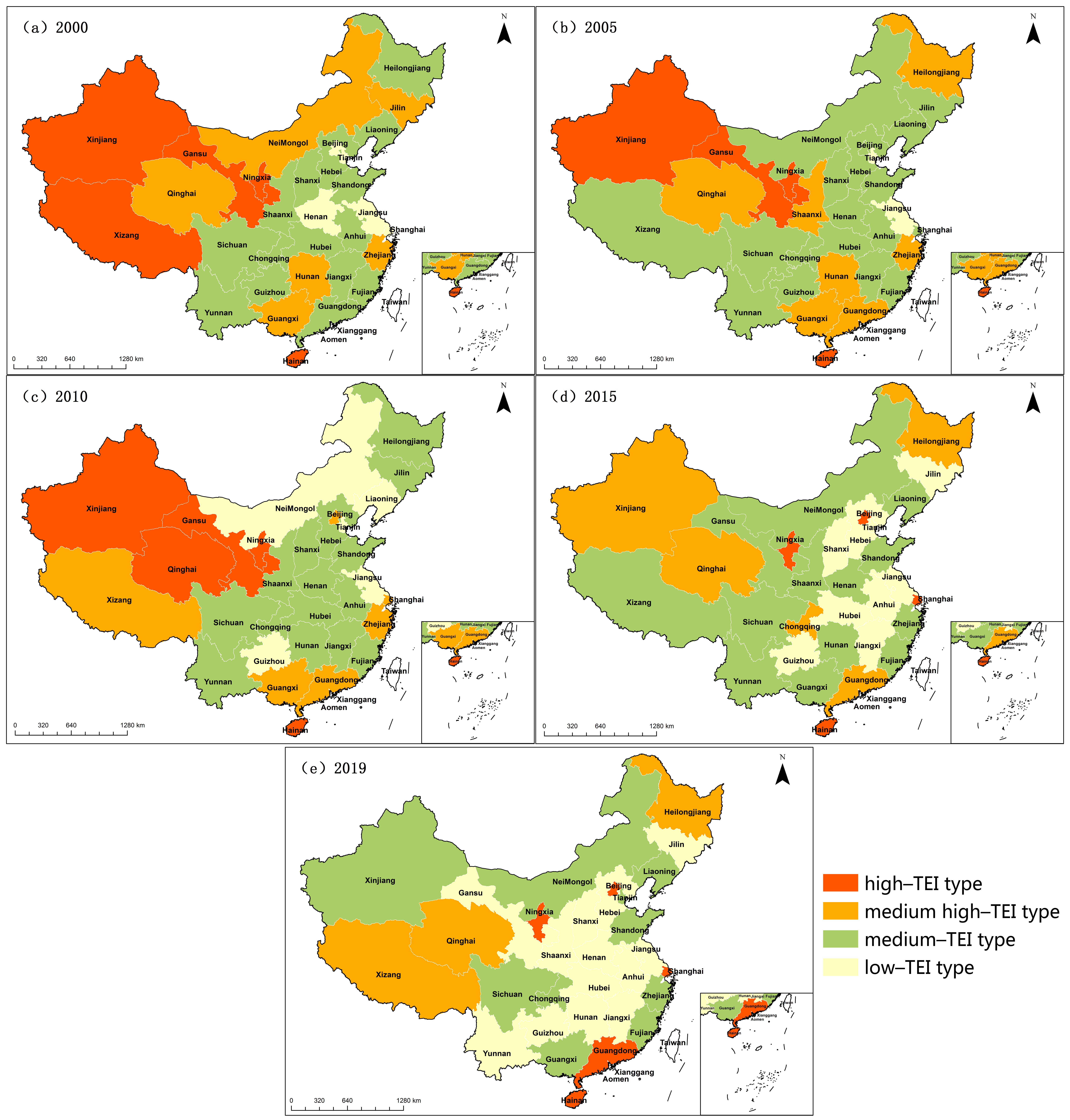



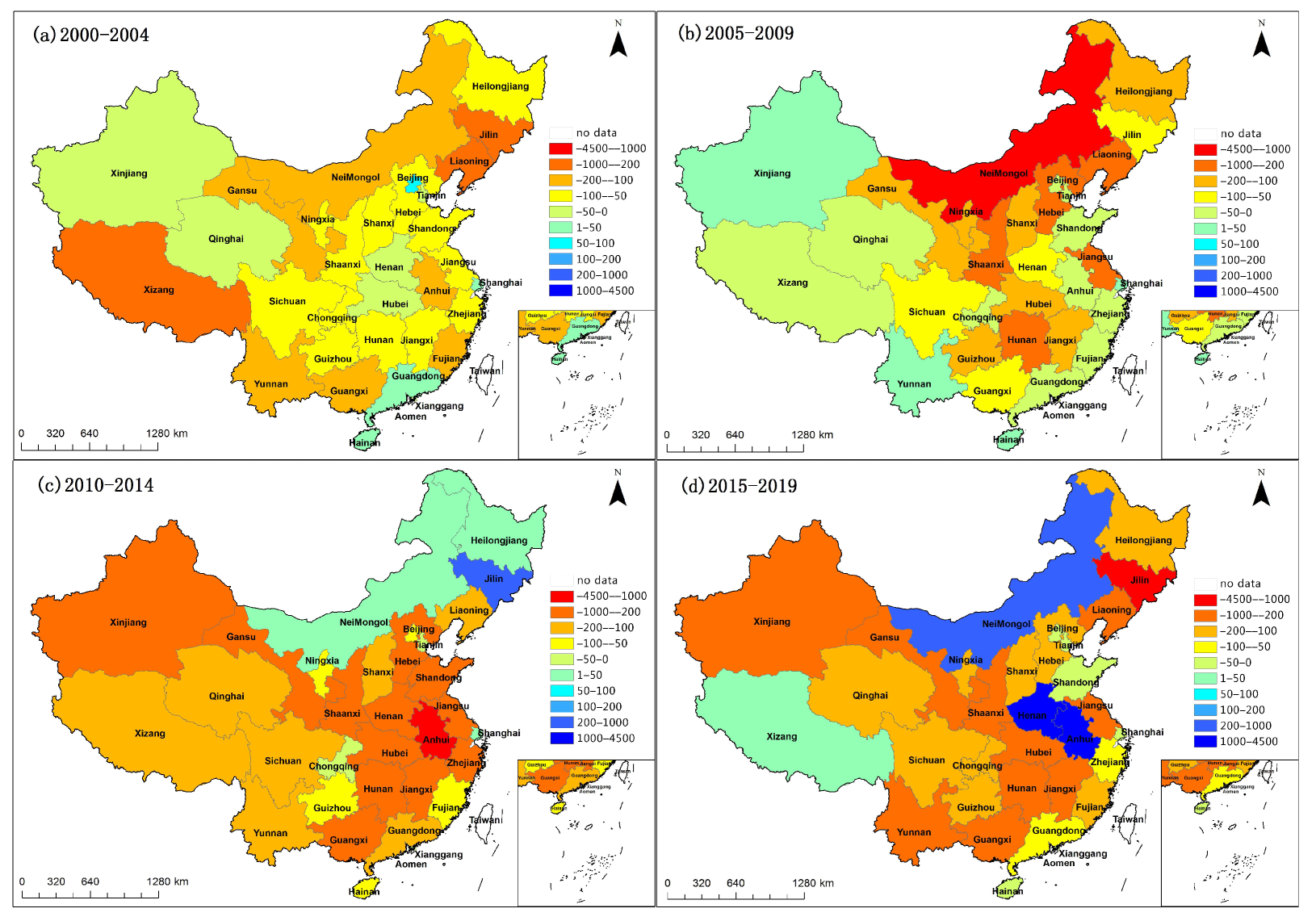
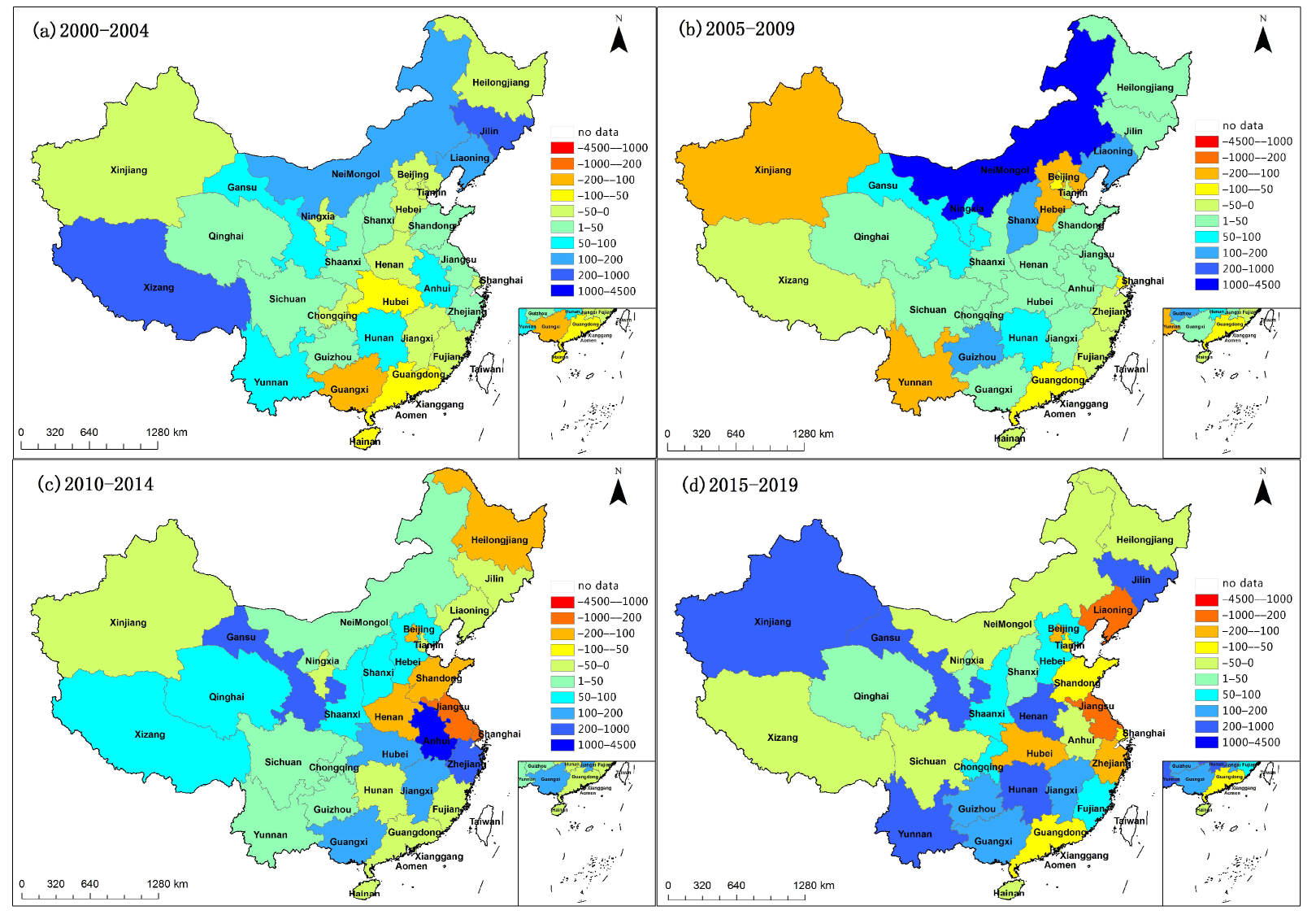

| Parameters | Explanation | Value |
|---|---|---|
| Transport modes, namely airlines, highways, railways, and waterways | — | |
| year | From the Statistical Yearbooks of various provinces in China (2001–2020) | |
| 64.7%, 13.8%, 31.6%, 10.6% for each transport mode, respectively [6,15] | ||
| 2, 1.8, 1, 0.9 MJ/pkm for each transport mode, respectively [6,72] | ||
| 137, 133, 27, and 106 g/pkm for each transport mode, respectively [54,73] | ||
| year | From the Statistical Yearbooks of provinces in China (2001–2020) | |
| year | From the Statistical Yearbooks of provinces in China (2001–2020) | |
| Energy consumption per bed night | 155 MJ per bed night [47,54] | |
| Carbon emissions per bed night | 43.2 g C/MJ per bed night [15] | |
| Activity types, namely sightseeing, leisure vacations, business conferences, visiting relatives/friends, and others | — | |
| year | From the Statistical Yearbooks of provinces in China (2001–2020) | |
| year | From the Inbound Tourist Sampling Survey Data (2001–2008), Sample survey data of domestic tourism in China (2001–2008), and Tourism Sampling Survey Data (2009–2020) | |
| , respectively [6,18] | ||
| , respectively [6,18] |
| Year | Inter-Regional Contribution Rate (%) | Intra-Regional Contribution Rate (%) | |||
|---|---|---|---|---|---|
| 2000 | 0.1198 | 0.0384 | 0.0814 | 32.03 | 67.97 |
| 2001 | 0.1145 | 0.0112 | 0.1033 | 9.77 | 90.23 |
| 2002 | 0.1056 | 0.0089 | 0.0968 | 8.39 | 91.61 |
| 2003 | 0.1037 | 0.0086 | 0.0951 | 8.31 | 91.69 |
| 2004 | 0.0745 | 0.0061 | 0.0684 | 8.18 | 91.82 |
| 2005 | 0.0775 | 0.0048 | 0.0727 | 6.25 | 93.75 |
| 2006 | 0.0859 | 0.0046 | 0.0812 | 5.41 | 94.59 |
| 2007 | 0.0947 | 0.0066 | 0.0881 | 6.98 | 93.02 |
| 2008 | 0.1287 | 0.0102 | 0.1185 | 7.91 | 92.09 |
| 2009 | 0.1312 | 0.0141 | 0.1171 | 10.75 | 89.25 |
| 2010 | 0.1331 | 0.0180 | 0.1151 | 13.55 | 86.45 |
| 2011 | 0.1334 | 0.0162 | 0.1171 | 12.18 | 87.82 |
| 2012 | 0.1270 | 0.0186 | 0.1083 | 14.66 | 85.34 |
| 2013 | 0.1716 | 0.0291 | 0.1425 | 16.97 | 83.03 |
| 2014 | 0.1773 | 0.0277 | 0.1495 | 15.65 | 84.35 |
| 2015 | 0.1884 | 0.0273 | 0.1611 | 14.50 | 85.50 |
| 2016 | 0.2449 | 0.0463 | 0.1986 | 18.90 | 81.10 |
| 2017 | 0.2774 | 0.0640 | 0.2134 | 23.08 | 76.92 |
| 2018 | 0.3072 | 0.0795 | 0.2277 | 25.87 | 74.13 |
| 2019 | 0.3323 | 0.0939 | 0.2384 | 28.27 | 71.73 |
| Year | Eastern Region | Central Region | Western Region | Northeastern Region |
|---|---|---|---|---|
| 2000 | 0.0571 | 0.0069 | 0.0163 | 0.0012 |
| 2001 | 0.0476 | 0.0078 | 0.0474 | 0.0005 |
| 2002 | 0.0541 | 0.0056 | 0.0364 | 0.0006 |
| 2003 | 0.0568 | 0.0035 | 0.0342 | 0.0006 |
| 2004 | 0.0448 | 0.0026 | 0.0203 | 0.0007 |
| 2005 | 0.0510 | 0.0028 | 0.0169 | 0.0020 |
| 2006 | 0.0597 | 0.0028 | 0.0163 | 0.0024 |
| 2007 | 0.0652 | 0.0040 | 0.0154 | 0.0035 |
| 2008 | 0.0925 | 0.0034 | 0.0196 | 0.0030 |
| 2009 | 0.0866 | 0.0028 | 0.0227 | 0.0050 |
| 2010 | 0.0901 | 0.0023 | 0.0186 | 0.0041 |
| 2011 | 0.0951 | 0.0022 | 0.0158 | 0.0051 |
| 2012 | 0.0886 | 0.0012 | 0.0132 | 0.0053 |
| 2013 | 0.1190 | 0.0022 | 0.0134 | 0.0079 |
| 2014 | 0.1224 | 0.0021 | 0.0114 | 0.0087 |
| 2015 | 0.1393 | 0.0031 | 0.0097 | 0.0094 |
| 2016 | 0.1678 | 0.0035 | 0.0132 | 0.0121 |
| 2017 | 0.1782 | 0.0038 | 0.0193 | 0.0124 |
| 2018 | 0.1906 | 0.0040 | 0.0205 | 0.0126 |
| 2019 | 0.1985 | 0.0045 | 0.0234 | 0.0129 |
| Year | Moran’s I | Z 1 | p | Year | Moran’s I | Z 1 | p |
|---|---|---|---|---|---|---|---|
| 2000 | 0.265 | 2.580 | 0.012 | 2010 | 0.198 | 2.233 | 0.029 |
| 2001 | 0.252 | 2.576 | 0.011 | 2011 | 0.194 | 2.267 | 0.023 |
| 2002 | 0.248 | 2.490 | 0.013 | 2012 | 0.197 | 2.437 | 0.021 |
| 2003 | 0.247 | 2.880 | 0.006 | 2013 | 0.139 | 1.948 | 0.044 |
| 2004 | 0.206 | 2.007 | 0.033 | 2014 | 0.104 | 1.514 | 0.074 |
| 2005 | 0.245 | 2.345 | 0.023 | 2015 | 0.056 | 0.984 | 0.155 |
| 2006 | 0.187 | 1.983 | 0.04 | 2016 | 0.062 | 1.117 | 0.127 |
| 2007 | 0.159 | 1.774 | 0.053 | 2017 | 0.059 | 1.033 | 0.147 |
| 2008 | 0.154 | 1.905 | 0.044 | 2018 | 0.070 | 1.154 | 0.127 |
| 2009 | 0.163 | 1.849 | 0.049 | 2019 | 0.070 | 1.125 | 0.131 |
| Factors | |||||||||||||
|---|---|---|---|---|---|---|---|---|---|---|---|---|---|
| Regions | Contribution (104 t) | Rate (%) | Contribution (104 t) | Rate (%) | Contribution (104 t) | Rate (%) | Contribution (104 t) | Rate (%) | Contribution (104 t) | Rate (%) | Contribution (104 t) | Rate (%) | |
| China | 167.81 | 1.07 | −570.88 | −3.64 | −12,602.17 | −80.36 | −1249.08 | −7.97 | 5563.67 | 35.48 | 24,372.58 | 155.42 | |
| East | 51.42 | 0.54 | −378.44 | −3.97 | −3618.72 | −37.94 | −3433.86 | −36.00 | 3144.31 | 32.96 | 13,774.18 | 144.40 | |
| Central | 13.99 | 0.82 | −9.36 | −0.55 | −2979.61 | −174.29 | 595.38 | 34.83 | 759.97 | 44.45 | 3329.16 | 194.74 | |
| West | 43.28 | 1.16 | −100.76 | −2.69 | −4869.52 | −129.98 | 1599.00 | 42.68 | 1314.75 | 35.10 | 5759.50 | 153.74 | |
| Northeast | 59.12 | 8.60 | −82.32 | −11.98 | −1134.31 | −165.05 | −9.60 | −1.40 | 344.64 | 50.15 | 1509.74 | 219.67 | |
Publisher’s Note: MDPI stays neutral with regard to jurisdictional claims in published maps and institutional affiliations. |
© 2022 by the authors. Licensee MDPI, Basel, Switzerland. This article is an open access article distributed under the terms and conditions of the Creative Commons Attribution (CC BY) license (https://creativecommons.org/licenses/by/4.0/).
Share and Cite
Chen, L.; Yi, L.; Cai, R.; Yang, H. Spatiotemporal Characteristics of the Correlation among Tourism, CO2 Emissions, and Economic Growth in China. Sustainability 2022, 14, 8373. https://doi.org/10.3390/su14148373
Chen L, Yi L, Cai R, Yang H. Spatiotemporal Characteristics of the Correlation among Tourism, CO2 Emissions, and Economic Growth in China. Sustainability. 2022; 14(14):8373. https://doi.org/10.3390/su14148373
Chicago/Turabian StyleChen, Lingling, Lin Yi, Rongrong Cai, and Hui Yang. 2022. "Spatiotemporal Characteristics of the Correlation among Tourism, CO2 Emissions, and Economic Growth in China" Sustainability 14, no. 14: 8373. https://doi.org/10.3390/su14148373
APA StyleChen, L., Yi, L., Cai, R., & Yang, H. (2022). Spatiotemporal Characteristics of the Correlation among Tourism, CO2 Emissions, and Economic Growth in China. Sustainability, 14(14), 8373. https://doi.org/10.3390/su14148373







